Part 6: Cameras, Machine Vision & OpenCV
Introduction¶
Exercises: 4
Estimated Completion Time: 2 hours
Aims¶
In this final part of the course you will finally make use of the TurtleBot3's camera, and look at how to work with images in ROS! Here we'll look at how to build ROS nodes that capture images and process them. We'll explore some ways in which this data can be used to inform decision-making in robotic applications.
Intended Learning Outcomes¶
By the end of this session you will be able to:
- Use a range of ROS tools to interrogate camera image topics on a ROS Network and view the images being streamed to them.
- Use the computer vision library OpenCV with ROS, to obtain camera images and process them in real-time.
- Apply filtering processes to isolate objects of interest within an image.
- Develop object detection nodes and harness the information generated by these processes to control a robot's position.
- Use camera data as a feedback signal to implement a line following behaviour using proportional control.
Quick Links¶
- Exercise 1: Using the
rqt_image_viewnode whilst changing the robot's viewpoint - Exercise 2: Object Detection
- Exercise 3: Locating image features using Image Moments
- Exercise 4: Line following
Additional Resources¶
- The Initial Object Detection Code (for Exercise 2)
- A Complete Worked Example of the
object_detection.pyNode - A
line_followerTemplate (for Exercise 4)
Getting Started¶
Step 1: Launch your ROS Environment
Launch your ROS environment now so that you have access to a Linux terminal instance (aka TERMINAL 1).
Step 2: Restore your work (WSL-ROS Managed Desktop Users ONLY)
Remember that any work that you do within the WSL-ROS Environment will not be preserved between sessions or across different University computers, and so you should be backing up your work to your U:\ drive regularly. When prompted (on first launch of WSL-ROS in TERMINAL 1) enter Y to restore this1.
Step 3: Launch VS Code
WSL users remember to check for this.
Step 4: Make Sure The Course Repo is Up-To-Date
Check that the Course Repo is up-to-date before you start on these exercises. See here for how to install and/or update.
Step 5: Launch the Robot Simulation
In this session we'll start by working with the same mystery world environment from Part 5. In TERMINAL 1, use the following roslaunch command to load it:
TERMINAL 1:
...and then wait for the Gazebo window to open: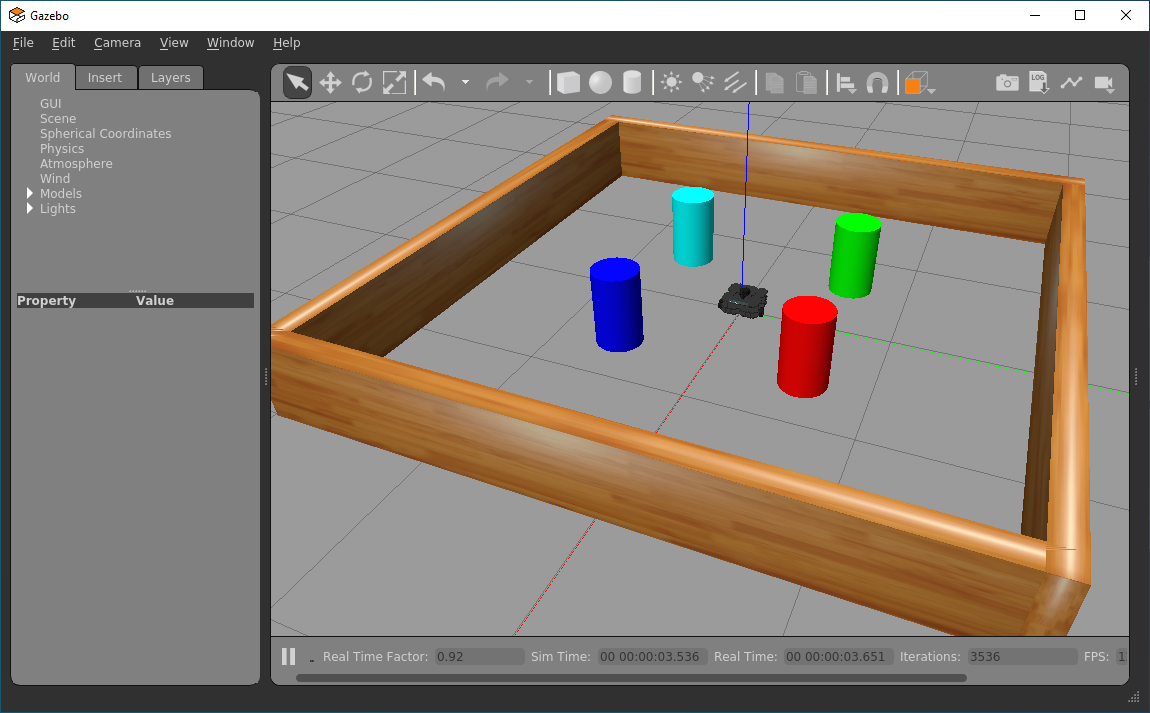
Working with Cameras and Images in ROS¶
Camera Topics and Data¶
There are a number of tools that we can use to view the live images that are being captured by a robot's camera in ROS. As with all robot data, these streams are published to topics, so we firstly need to identify those topics.
In a new terminal instance (TERMINAL 2), run rostopic list to see the full list of topics that are currently active on our system. Conveniently, all the topics related to our robot's camera are prefixed with camera! Filter the rostopic list output using grep (a Linux command), to filter the list and only show topics prefixed with /camera:
TERMINAL 2:
This should provide the following filtered list:
/camera/depth/camera_info
/camera/depth/image_raw
/camera/depth/points
/camera/parameter_descriptions
/camera/parameter_updates
/camera/rgb/camera_info
/camera/rgb/image_raw
/camera/rgb/image_raw/compressed
/camera/rgb/image_raw/compressed/parameter_descriptions
/camera/rgb/image_raw/compressed/parameter_updates
/camera/rgb/image_raw/compressedDepth
/camera/rgb/image_raw/compressedDepth/parameter_descriptions
/camera/rgb/image_raw/compressedDepth/parameter_updates
/camera/rgb/image_raw/theora
/camera/rgb/image_raw/theora/parameter_descriptions
/camera/rgb/image_raw/theora/parameter_updates
Our real TurtleBot3 Waffles in the Diamond have a slightly different camera module to that used by the simulated robots that we are working with here. Despite this though, the camera data on our real robots is published to topics using the same ROS message formats as used in simulation, making it fairly straight-forward to transfer nodes that we develop in simulation here onto the real robots2.
The first items in the list of camera topics above tell us that depth information is available here. Much like the real robots, the simulated versions that we are working with here also have a camera module capable of determining depth information as well as simply capturing images. Remember from Part 3 though, that we also have a very capable LiDAR sensor to give us this type of information too, and so we won't really be using the depth capabilities of our camera in this session.
The main thing we are actually interested in here is the RGB images that are captured by the camera, and the key topic that we'll therefore be using here is:
Run rostopic info on this to identify the message type.
Now, run rosmsg info on this message type to find out exactly what information is published to the topic. You should end up with a list that looks like this:
std_msgs/Header header
uint32 seq
time stamp
string frame_id
uint32 height
uint32 width
string encoding
uint8 is_bigendian
uint32 step
uint8[] data
Questions
- What type of message is used on this topic, and which package is this message derived from?
- Using
rostopic echoand the information about the topic message (as shown above) determine the size of the images that our robot's camera will capture (i.e. its dimensions, in pixels). It will be quite important to know this when we start manipulating these camera images later on. - Finally, considering the list above again, which part of the message do you think contains the actual image data?
Visualising Camera Streams¶
We can view the images being streamed to the above camera topic (in real-time) in a variety of different ways, and we'll explore a couple of these now.
One way is to use RViz, which can be launched using the following roslaunch command:
TERMINAL 2:
Once RViz launches, find the camera item in the left-hand panel and tick the checkbox next to it. This should open up a camera panel with a live stream of the images being obtained from the robot's camera! The nice thing about this is that the real-time LiDAR data will also be overlaid on top of the images too!

Close down RViz by entering Ctrl+C in TERMINAL 2.
Exercise 1: Using the RQT Image View node whilst changing the robot's viewpoint¶
Another tool we can use to view camera data-streams is the rqt_image_view node.
-
To launch this, use
rosrunas follows:
TERMINAL 2:
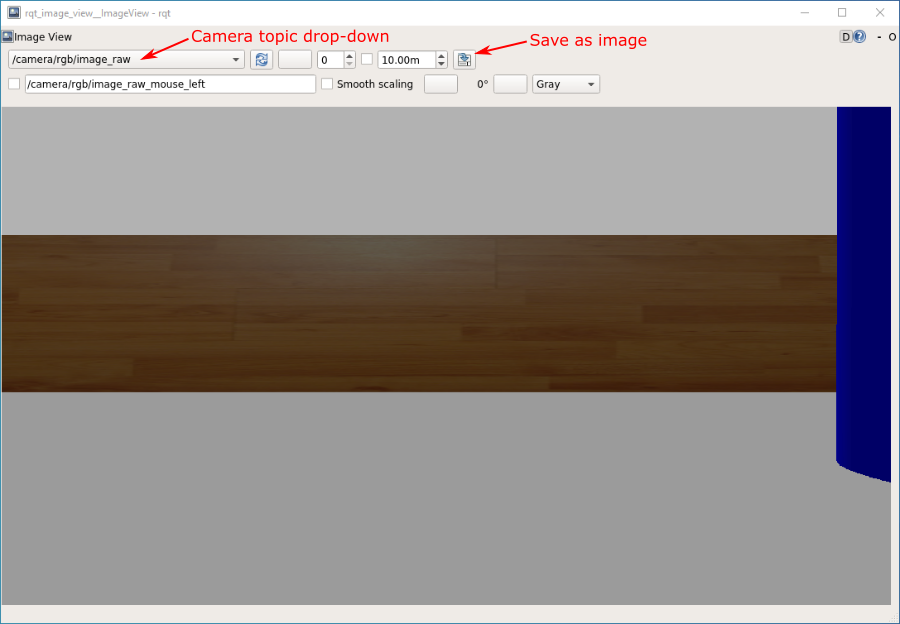
This is a nice tool that allows us to easily view images that are being published to any camera topic on the ROS network. Another useful feature is the ability to save these images (as
.jpgfiles) to the filesystem: See the "Save as image" button highlighted in the figure above. This might be useful later on...
-
Click the drop-down box in the top left of the window to select an image topic to display. Select
/camera/rgb/image_raw(if it's not already selected). -
Keep this window open now, and launch a new terminal instance (TERMINAL 3).
-
Launch the
turtlebot3_teleopnode, either using the full command or a handy alias:tb3_teleop! Rotate your robot on the spot, keeping an eye on therqt_image_viewwindow as you do this. Stop the robot once one of the coloured pillars in the arena is roughly in the centre of the robot's field of vision, then close theturtlebot3_teleopnode and therqt_image_viewnode by entering Ctrl+C in TERMINAL 3 and TERMINAL 2 respectively.
OpenCV and ROS¶
OpenCV is a mature and powerful computer vision library designed for performing real-time image analysis, and it is therefore extremely useful for robotic applications. The library is cross-platform and there is a Python API (cv2), which we'll be using to do some computer vision tasks of our own during this lab session. While we can work with OpenCV using Python straight away (via the API), the library can't directly interpret the native image format used by the ROS, so there is an interface that we need to use. The interface is called CvBridge, which is a ROS package that handles the conversion between ROS and OpenCV image formats. We'll therefore need to use these two libraries (OpenCV and CvBridge) hand-in-hand when developing ROS nodes to perform computer vision related tasks.
Object Detection¶
One common job that we often want a robot to perform is object detection, and we will illustrate how this can be achieved using OpenCV tools for colour filtering, to detect the coloured pillar that your robot should now be looking at.
Exercise 2: Object Detection¶
In this exercise you will learn how to use OpenCV to capture images, filter them and perform other analysis to confirm the presence and location of features that we might be interested in.
Step 1
- First create a new package in your
catkin_ws/srcdirectory calledpart6_visionwithrospy,cv_bridge,sensor_msgsandgeometry_msgsas dependencies. - Then, run
catkin buildon the package and then re-source your environment (as you've done so many times by now!) - In the
srcfolder of the package you have just created, create a new Python file calledobject_detection.py. What else do we need to do to this file before we can run it? Do it now! - Copy the code here, save the file, then read the annotations so that you understand how this node works and what should happen when you run it.
-
Run the node using
rosrun.Warning
This node will capture an image and display it in a pop-up window. Once you've viewed the image in this pop-up window MAKE SURE YOU CLOSE THE POP-UP WINDOW DOWN so that the node can complete its execution!
-
As you should know from reading the explainer, the node has just obtained an image and saved it to a location on the filesystem. Navigate to this filesystem location and view the image using
eog.
What you may have noticed from the terminal output when you ran the object_detection.py node is that the robot's camera captures images at a native size of 1080x1920 pixels (you should already know this from interrogating the /camera/rgb/image_raw/width and /height messages using rostopic echo earlier, right?!). That's over 2 million pixels in total in a single image (2,073,600 pixels per image, to be exact), each pixel having a blue, green and red value associated with it - so that's a lot of data in a single image file!
Question
The size of the image file (in bytes) was actually printed to the terminal when you ran the object_detection.py node. Did you notice how big it was exactly?
Processing an image of this size is therefore hard work for a robot: any analysis we do will be slow and any raw images that we capture will occupy a considerable amount of storage space. The next step then is to reduce this down by cropping the image to a more manageable size.
Step 2
We're going to modify the object_detection.py node now to:
- Capture a new image in its native size
- Crop it down to focus in on a particular area of interest
-
Save both of the images (the cropped one should be much smaller than the original).
-
In your
object_detection.pynode locate the line: -
Underneath this, add the following additional lines of code:
-
Run the node again.
Remember
Make sure you close all of these pop-up windows down after viewing them to ensure that all your images are saved to the filesystem and the node completes all of its tasks successfully.
The code that you have just added here has created a new image object called
cropped_img, from a subset of the original by specifying a desiredcrop_heightandcrop_widthrelative to the original image dimensions. Additionally, we have also specified where in the original image (in terms of pixel coordinates) we want this subset to start, usingcrop_y0andcrop_z0. This process is illustrated in the figure below: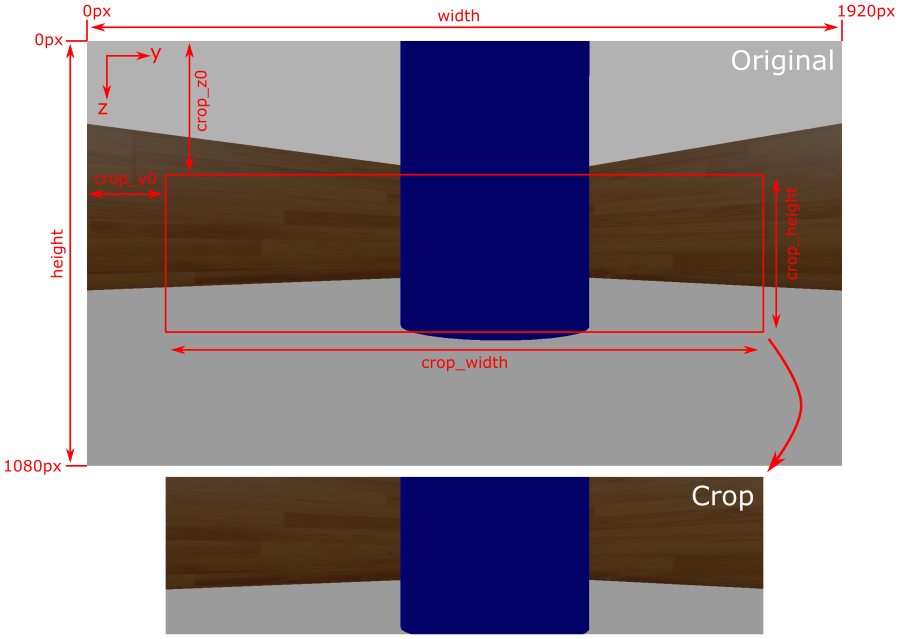
The original image (
This may seem quite confusing, but hopefully the figure below illustrates what's going on here:cv_img) is cropped using a process called "slicing":
Step 3
As discussed above, an image is essentially a series of pixels each with a blue, green and red value associated with it to represent the actual image colours. From the original image that we have just obtained and cropped, we then want to get rid of any colours other than those associated with the pillar that we want the robot to detect. We therefore need to apply a filter to the pixels, which we will ultimately use to discard any pixel data that isn't related to the coloured pillar, whilst retaining data that is.
This process is called masking and, to achieve this, we need to set some colour thresholds. This can be difficult to do in a standard Blue-Green-Red (BGR) or Red-Green-Blue (RGB) colour space, and you can see a good example of this in this article from RealPython.com. We will apply some steps discussed in this article to convert our cropped image into a Hue-Saturation-Value (HSV) colour space instead, which makes the process of colour masking a bit easier.
-
First, analyse the Hue and Saturation values of the cropped image. To do this, first navigate to the "myrosdata/object_detection" directory, where the raw image has been saved:
TERMINAL 2:
Then, run the following ROS Node (from the
tuos_examplespackage), supplying the name of the cropped image as an additional argument:
-
The node should produce a scatter plot, illustrating the Hue and Saturation values of each of the pixels in the image. Each data point in the plot represents a single image pixel and each is coloured to match its RGB value:
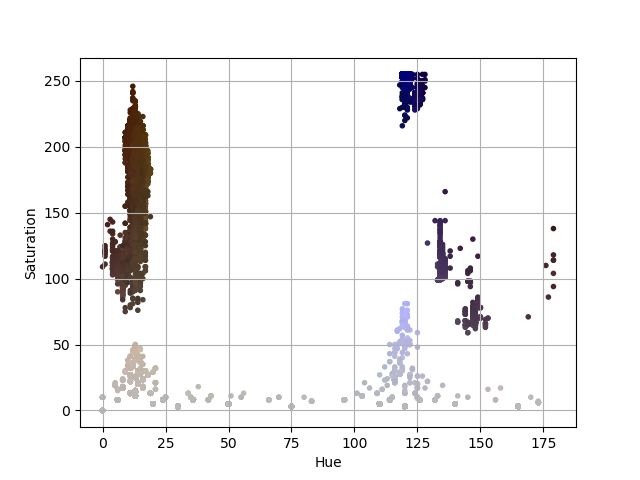
-
You should see from the image that all the pixels related to the coloured pillar that we want to detect are clustered together. We can use this information to specify a range of Hue and Saturation values that can be used to mask our image: filtering out any colours that sit outside this range and thus allowing us to isolate the pillar itself. The pixels also have a Value (or "Brightness"), which isn't shown in this plot. As a rule of thumb, a range of brightness values between 100 and 255 generally works quite well.
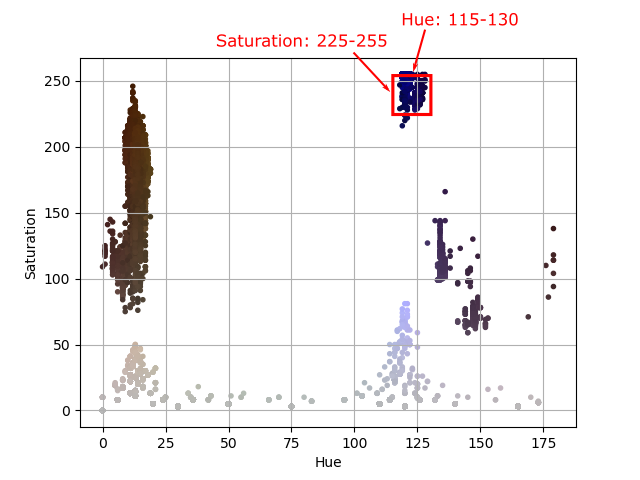
In this case then, we select upper and lower HSV thresholds as follows:
Use the plot that has been generated here to determine your own upper and lower thresholds.
OpenCV contains a built-in function to detect which pixels of an image fall within a specified HSV range:
cv2.inRange(). This outputs a matrix, the same size and shape as the number of pixels in the image, but containing onlyTrue(1) orFalse(0) values, illustrating which pixels do have a value within the specified range and which don't. This is known as a Boolean Mask (essentially, a series of ones or zeroes). We can then apply this mask to the image, using a Bitwise AND operation, to get rid of any image pixels whose mask value isFalseand keep any flagged asTrue(or in range). -
To do this, first locate the following line in your
object_detection.pynode: -
Underneath this, add the following:
-
Now, run the node again. Three images should be generated and saved now. As shown in the figure below, the third image should simply be a black and white representation of the cropped image, where the white regions should indicate the areas of the image where pixel values fall within the HSV range specified earlier. Notice (from the text printed to the terminal) that the cropped image and the image mask have the same dimensions, but the image mask file has a significantly smaller file size. While the mask contains the same number of pixels, these pixels only have a value of
1or0, whereas - in the cropped image of the same pixel size - each pixel has a Red, Green and Blue value: each ranging between0and255, which represents significantly more data.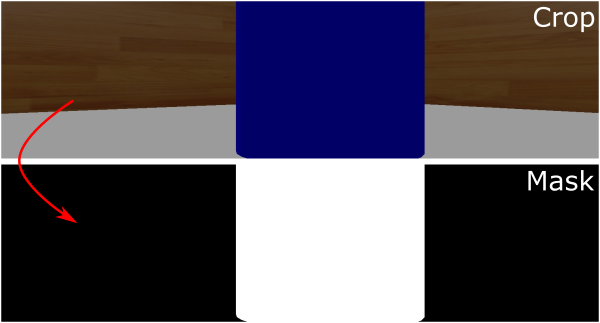
Finally, we can apply this mask to the cropped image, generating a final version of it where only pixels marked as True in the mask retain their RGB values, and the rest are simply removed. As discussed earlier, we use a Bitwise AND operation to do this and, once again, OpenCV has a built-in function to do this: cv2.bitwise_and().
-
Locate the following line in your
object_detection.pynode: -
And, underneath this, add the following:
-
Run this node again, and a fourth image should also be generated now, this time showing the cropped image taken from the robot's camera, but only containing data related to coloured pillar, with all other background image data removed (and rendered black):
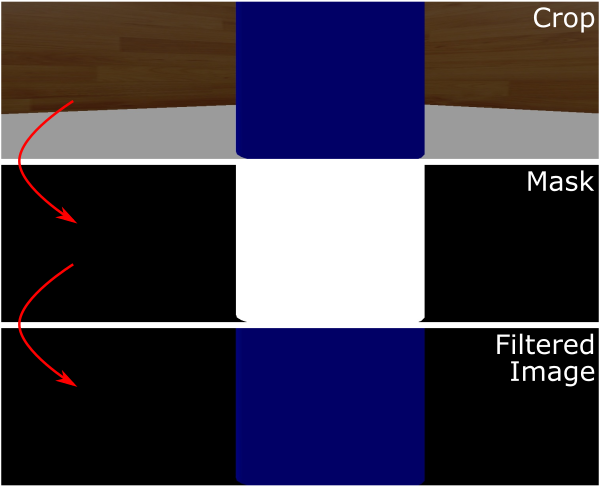
Image Moments¶
You have now successfully isolated an object of interest within your robot's field of vision, but perhaps we want to make our robot move towards it, or - conversely - make our robot navigate around it and avoid crashing into it! We therefore also need to know the position of the object in relation to the robot's viewpoint, and we can do this using image moments.
The work we have just done above led to us obtaining what is referred to as a colour blob. OpenCV also has built-in tools to allow us to calculate the centroid of a colour blob like this, allowing us to determine where exactly within an image the object of interest is located (in terms of pixels). This is done using the principle of image moments: essentially statistical parameters related to an image, telling us how a collection of pixels (i.e. the blob of colour that we have just isolated) are distributed within it. You can read more about Image Moments here, which tells us that the central coordinates of a colour blob can be obtained by considering some key moments of the image mask that we obtained from thresholding earlier:
M00: the sum of all non-zero pixels in the image mask (i.e. the size of the colour blob, in pixels)M10: the sum of all the non-zero pixels in the horizontal (y) axis, weighted by row numberM01: the sum of all the non-zero pixels in the vertical (z) axis, weighted by column number
Remember
We refer to the horizontal as the y-axis and the vertical as the z-axis here, to match the terminology that we have used previously to define our robot's principal axes.
We don't really need to worry about the derivation of these moments too much though. OpenCV has a built-in moments() function that we can use to obtain this information from an image mask (such as the one that we generated earlier):
So, using this we can obtain the y and z coordinates of the blob centroid quite simply:
Question
We're adding a very small number to the M00 moment here to make sure that the divisor in the above equations is never zero and thus ensuring that we never get caught out by any "divide-by-zero" errors. Why might this be necessary?

Once again, there is a built-in OpenCV tool that we can use to add a circle onto an image to illustrate the centroid location within the robot's viewpoint: cv2.circle(). This is how we produced the red circle that you can see in the figure above. You can see how this is implemented in a complete worked example of the object_detection.py node from the previous exercise.
In our case, we can't actually change the position of our robot in the z axis, so the cz centroid component here might not be that important to us for navigation purposes. We may however want to use the centroid coordinate cy to understand where a feature is located horizontally in our robot's field of vision, and use this information to turn towards it (or away from it, depending on what we are trying to achieve). We can then use this as the basis for some real closed-loop control.
Exercise 3: Locating image features using Image Moments¶
Inside the tuos_examples package there is a node that has been developed to illustrate how all the OpenCV tools that you have explored so far could be used to search an environment and stop a robot when it is looking directly at an object of interest. All the tools that are used in this node should be familiar to you by now, and in this exercise you're going to make a copy of this node and modify it to enhance its functionality.
-
The node is called
colour_search.py, and it is located in thesrcfolder of thetuos_examplespackage. Copy this into thesrcfolder of your ownpart6_visionpackage by first ensuring that you are located in the desired destination folder:
TERMINAL 2:
-
Then, copy the
colour_search.pynode usingcpas follows:
TERMINAL 2:
-
You'll need to copy the
tb3.pymodule across from thetuos_examplespackage, as this is used by thecolour_search.pynode to make the robot move:
TERMINAL 2:
-
Open up the
colour_search.pyfile in VS Code to view the content. Have a look through it and see if you can make sense of how it works. The overall structure should be fairly familiar to you by now: we have a Python class structure, a Subscriber with a callback function, a main loop where all the robot control takes place and a lot of the OpenCV tools that you have explored so far in this session. Essentially this node functions as follows:- The robot turns on the spot whilst obtaining images from its camera (by subscribing to the
/camera/rgb/image_rawtopic). - Camera images are obtained, cropped, then a threshold is applied to the cropped images to detect the blue pillar in the simulated environment.
- If the robot can't see a blue pillar then it turns on the spot quickly.
- Once detected, the centroid of the blue blob representing the pillar is calculated to obtain its current location in the robot's viewpoint.
- As soon as the blue pillar comes into view the robot starts to turn more slowly instead.
- The robot stops turning as soon as it determines that the pillar is situated directly in front of it (determined using the
cycomponent of the blue blob centroid). - The robot then waits for a while and then starts to turn again.
- The whole process repeats until it finds the blue pillar once again.
- The robot turns on the spot whilst obtaining images from its camera (by subscribing to the
- Run the node as it is to see this in action. Observe the messages that are printed to the terminal throughout execution.
- Your task is to then modify the node so that it stops in front of every coloured pillar in the arena (there are four in total). For this, you may need to use some of the methods that you have explored in the previous exercises.
- You might first want to use some of the methods that we used to obtain and analyse some images from the robot's camera:
- Use the
turtlebot3_teleopnode to manually move the robot, making it look at every coloured pillar in the arena individually. - Run the
object_detection.pynode that you developed in the previous exercise to capture an image, crop it, save it to the filesystem and then feed this cropped image into theimage_colours.pynode from thetuos_examplespackage (as you did earlier) - From the plot that is generated by the
image_colours.pynode, determine some appropriate HSV thresholds to apply for each coloured pillar in the arena.
- Use the
- Once you have the right thresholds, then you can add these to your
colour_search.pynode so that it has the ability to detect every pillar in the same way that it currently detects the blue one.
- You might first want to use some of the methods that we used to obtain and analyse some images from the robot's camera:
PID Control and Line Following¶
Line following is a handy skill for a robot to have! We can achieve this on our TurtleBot3 using its camera system and the image processing techniques that have been covered so far in this session.
COM2009 Lecture 6 introduces a well established algorithm for closed-loop control known as PID Control, and this can be used to achieve such line following behaviour.
At the heart of this is the principle of Negative-Feedback control, which considers a Reference Input, a Feedback Signal and the Error between these.

Adapted from Arturo Urquizo (via Wikimedia Commons)
The Reference Input represents a desired state that we would like our system to maintain. If we want our TurtleBot3 to successfully follow a coloured line on the floor, we will need it to keep the colour blob that represents that coloured line in the centre of its view point at all times. The desired state would therefore be to maintain the cy centroid of the colour blob in the centre of its vision.
A Feedback Signal informs us of what the current state of the system actually is. In our case, this feedback signal would be the real-time location of the coloured line in the live camera images, i.e. its cy centroid (obtained using processing methods such as those covered in Exercise 3 above).
The difference between these two things is the Error, and the PID control algorithm provides us with a means to control this error and minimise it, so that our robot's actual state matches the desired state. i.e.: the coloured line is always in the centre of its viewpoint.
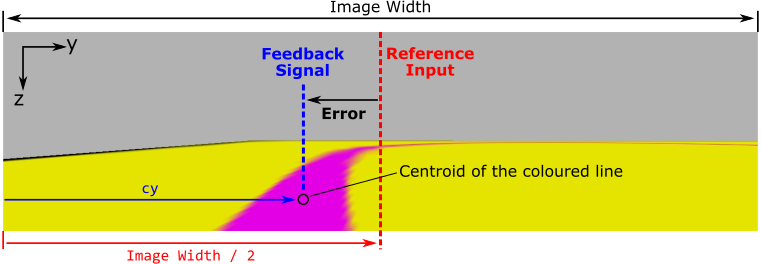
The PID algorithm is as follows:
Where \(u(t)\) is the Controlled Output, \(e(t)\) is the Error (as illustrated in the figure above) and \(K_{P}\), \(K_{I}\) and \(K_{D}\) are Proportional, Integral and Differential Gains respectively. These three gains are constants that must be established for any given system through a process called tuning. This tuning process is discussed in COM2009 Lecture 6, but you will also explore this in the practical exercise that follows.
Exercise 4: Line Following¶
Part A: Setup¶
- Make sure that all ROS processes from the previous exercise are shut down now, including the
colour_search.pynode, and the Gazebo simulation in TERMINAL 1. -
In TERMINAL 1 launch a new simulation from the
tuos_simulationspackage:
TERMINAL 1:
Your robot should be launched onto a long thin track with a straight pink line painted down the middle of the floor:

-
In TERMINAL 2 you should still be located in your
part6_vision/srcdirectory, but if not then go there now:
TERMINAL 2:
-
Perform the necessary steps to create a new empty Python file called
line_follower.pyand prepare it for execution. -
Once that's done open up the empty file in VS Code.
-
Start with the code template provided here. This template contains three "TODOs" that you need to complete, all of which are explained in detail in the code annotations, so read these carefully. Ultimately, you did all of this in Exercise 2, so go back here if you need a reminder on how any of this works.
Your aim here is to get the code to generate a cropped image, with the coloured line isolated and located within it, like this:

Part B: Implementing and Tuning a Proportional Controller¶
Referring back to the equation for the PID algorithm as discussed above, the Proportional, Integral and Differential components all have different effects on a system in terms of its ability to maintain the desired state (the reference input). The gain terms associated with each of these components (\(K_{P}\), \(K_{I}\) and \(K_{D}\)) must be tuned appropriately for any given system in order to achieve stability of control.
A PID Controller can actually take three different forms:
- "P" Control: Only a Proportional gain (\(K_{P}\)) is used, all other gains are set to zero.
- "PI" Control: Proportional and Integral gains (\(K_{P}\) and \(K_{I}\)) are applied, the Differential gain is set to zero.
- "PID" Control: The controller makes use of all three gain terms (\(K_{P}\), \(K_{I}\) and \(K_{D}\))
In order to allow our TurtleBot3 to follow a line, we actually only really need a "P" Controller, so our control equation becomes quite simple, reducing to:
The next task then is to adapt our line_follower.py node to implement this control algorithm and find a proportional gain that is appropriate for our system.
-
Return to your
line_follower.pyfile. Underneath the line that reads:Paste the following additional code:
kp = 0.01 reference_input = {BLANK} feedback_signal = cy error = feedback_signal - reference_input ang_vel = kp * error print(f"Error = {error:.1f} pixels | Control Signal = {ang_vel:.2f} rad/s")Fill in the Blank!
What is the Reference Input to the control system (
reference_input)? Refer to this figure from earlier.Here we have implemented our "P" Controller. The Control Signal that is being calculated here is the angular velocity that will be applied to our robot (the code won't make the robot move just yet, but we'll get to that bit shortly!) The Controlled Output will therefore be the angular position (i.e. the yaw) of the robot.
-
Run the code as it is, and consider the following:
- What proportional gain (\(K_{P}\)) are we applying?
- What is the maximum angular velocity that can be applied to our robot? Is the angular velocity that has been calculated actually appropriate?
- Is the angular velocity that has been calculated positive or negative? Will this make the robot turn in the right direction and move towards the line?
-
Let's address the third question (c) first...
A positive angular velocity should make the robot turn anti-clockwise (i.e. to the left), and a negative angular velocity should make the robot turn clockwise (to the right). The line should currently be to the left of the robot, which means a positive angular velocity would be required in order to make the robot turn towards it. If the value of the Control Signal that is being calculated by our proportional controller (as printed to the terminal) is negative, then this isn't correct, so we need to change the sign of our proportional gain (\(K_{P}\)) in order to correct this:
-
Next, let's address the second of the above questions (b)...
The maximum angular velocity that can be applied to our robot is ±1.82 rad/s. If our proportional controller is calculating a value for the Control Signal that is greater than 1.82, or less than -1.82 then this needs to be limited. In between the following two lines of code:
Insert the following:
-
Finally, we need to think about the actual proportional gain that is being applied. This is where we need to actually tune our system by finding a proportional gain value that controls our system appropriately.
Return to your
line_follower.pyfile. Underneath the line that reads:Paste the following:
Fill in the Blank!
There is a method within the
Tb3Move()class which allows us to publish a velocity command to the/cmd_veltopic. What is it? (Have a look at thetb3.pysource code, or thecolour_search.pyfile from Exercise 3 if you need a reminder).Having filled in the
{BLANK}, the code will now make the robot move with a constant linear velocity of 0.1 m/s at all times, while its angular velocity will be determined by our proportional controller, based on the controller error and the proportional gain parameterkp.The figure below illustrates the effects different values of proportional gain can have on a system.

Courtesy of Prof. Roger Moore
Taken from COM2009 Lecture 6: PID ControlRun the code and see what happens. You should find that the robot behaves quite erratically, indicating that
kp(at an absolute value of 0.01) is probably too large. -
Try reducing
kpby a factor of 100:kp = -0.0001. Before you run the code again, you can reset the Gazebo simulation by pressing Ctrl+Shift+R so that the robot returns to the starting position.You should find that the robot now gradually approaches the line, but it can take a while for it to do so.
-
Next, increase
kpby a factor of 10:kp = -0.001. Once again, reset the robot back to its starting position in Gazebo by using Ctrl+Shift+R to reset the simulation.The robot should now reach the line much quicker, and follow the line well once it reaches it.
-
Could
kpbe modified any more to improve the control further? Play around a bit more and see what happens. We'll but this to the test on a more challenging track in the next part of this exercise.
Part C: Advanced Line Following¶
-
Now, in TERMINAL 1 run a new simulation:
TERMINAL 1:
Your robot should be launched into an environment with a more interesting line to follow:
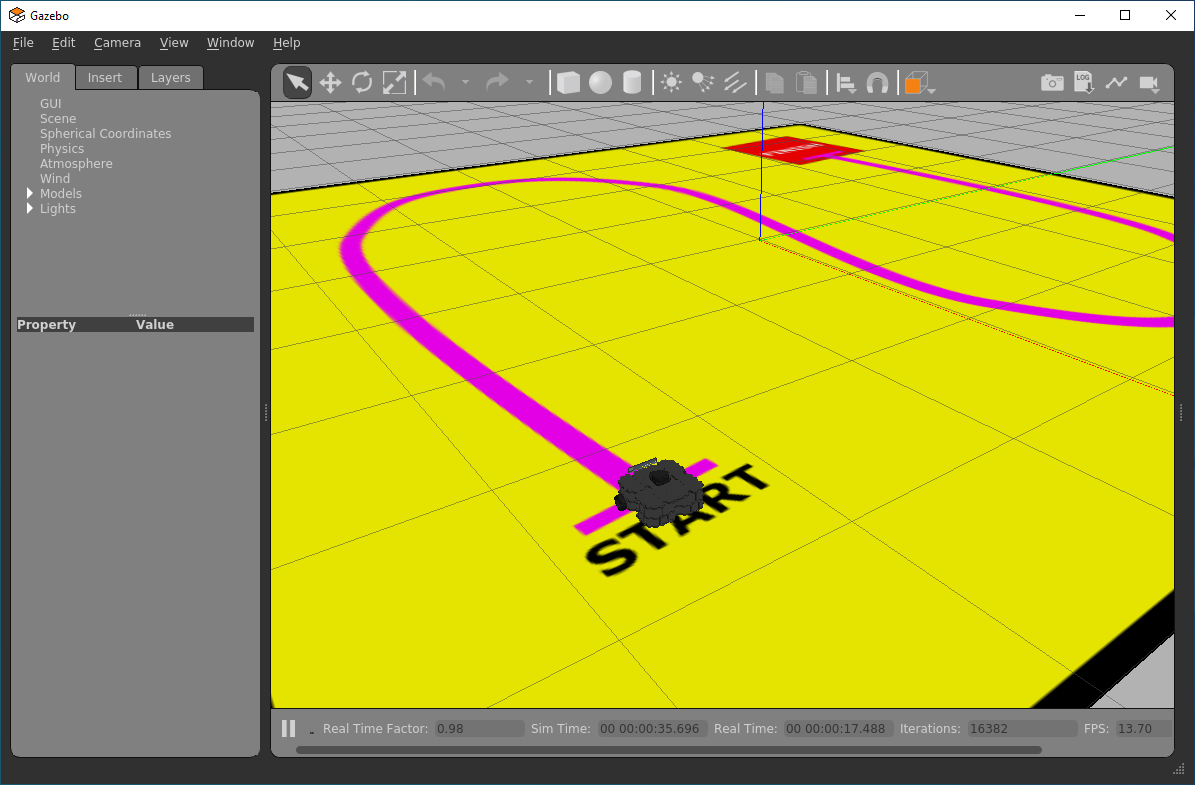
-
In TERMINAL 2, run your
line_follower.pynode and see how it performs. Does your proportional gain need to be adjusted further to optimise the performance? -
Next, think about conditions where the line can't initially be seen...
As you know, the angular velocity is determined by considering the
cycomponent of a colour blob representing the line. What happens in situations where the blob of colour isn't there though? What influence would this have on the Control Signals that are calculated by the proportional controller? To consider this further, try launching the robot in the same arena but in a different location instead, and think about how you might approach this situation:
TERMINAL 1:
-
Finally, what happens when the robot reaches the finish line? How could you add additional functionality to ensure that the robot stops when it reaches this point? What features of the arena could you use to trigger this?
Wrapping Up¶
In this session you have learnt how to use data from a robot's camera to extract further information about its environment. The camera allows our robot to "see" and the information that we obtain from this device can allow us to develop more advanced robotic behaviours such as searching for objects, follow things or - conversely - moving away or avoiding them. You have learnt how to do some basic tasks with OpenCV, but this is a huge and very capable library of computer vision tools, and we encourage you to explore this further yourselves to enhance some of the basic principles that we have shown you today.
WSL-ROS Managed Desktop Users: Save your work!¶
Remember, to save the work you have done in WSL-ROS during this session so that you can restore it on a different machine at a later date. Run the following script in any idle WSL-ROS Terminal Instance now:
You'll then be able to restore it to a fresh WSL-ROS environment whenever you need it again (wsl_ros restore).